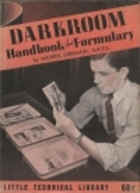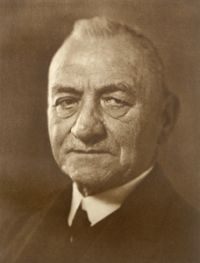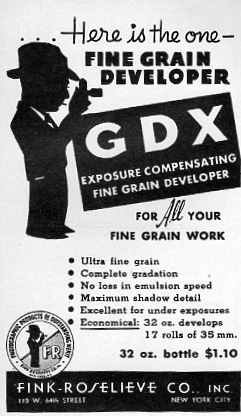| Germain Fine-grain Developer | |
Originally suggested by
the writer and photographer Morris
Germain in the 1930's, this formula has never been widely used, but it
deserves to be. The original is found in Germain's "Darkroom
Handbook and Formulary" which was part of the Ziff Davis
"Little Technical Library". It has also been posted on the Internet, along with some initial speculation, later abandoned, that it may be the original formula for Harvey's 777 Panthermic, which was introduced commercially in 1938. The speculation was based on this formula's use of 7 grams each of three ingredients. The Internet article is fascinating, and can be seen here: unblinking eye 777 article. It is not possible for us to know the
formulation of Harvey's 777 Panthermic, as originally sold by Defender, later by
Dupont, and currently by BPI. That original formula was never made
public, and it has been modified and updated several times since 1938. The
powder mixture of today's 777 Panthermic has a very different appearance from
the powders that make up the Germain developer and the 777 definitely contains
carbonate, which Germain's developer does not. This does not detract from the usefulness
of Germain's developer. It has a very long shelf life, and gives
outstanding images on most black and white films. |
|
| Water, plus a pinch of sodium sulfite | 665 ml |
| Metol (Metol causes dermatitis in some individuals.) |
7 g |
| Sodium sulfite | 70 g |
| Paraphenylindiamine (base) (Poisonous. Handle paraphenylindiamine with caution. Causes dermatitis in some individuals. Pronounced staining properties.) |
7 g |
| Glycin* | 7 g |
| Water to make | 1000 ml |
| Mix in the order shown, but
before adding the metol to the water, mix in a pinch of the sulfite.
This prevents the metol from oxidizing immediately. Be sure each
chemical is completely dissolved before adding the next.
Developing times vary according to the film you use, and you should experiment with times between about 9 and 18 minutes. Agitate 30 seconds initially, then 10 seconds each minute thereafter. *Buy hard-to-find chemicals from Photographers
Formulary. Pro-oriented camera stores often sell Metol and
sulfite. |
|

